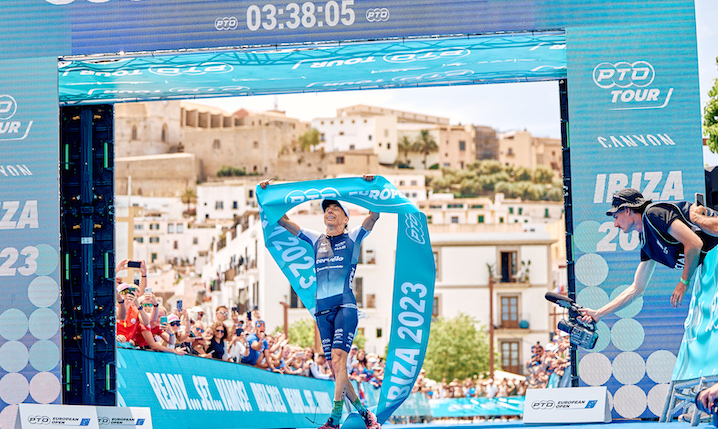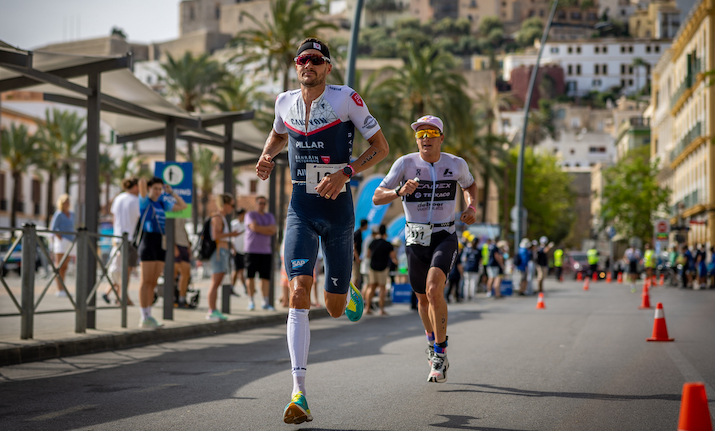PTO Tour Ibiza Part Two: FilmNova and the PTO overcome island challenges to tell triathlon story

Germany’s Anne Haug wins the women’s race in Ibiza
The Professional Triathletes Organisation came to Ibiza on the first weekend of May, with a host of the world’s best triathletes taking to the water, running and cycling the course, and a bigger broadcast reach than ever before. However, holding the PTO Tour 2023 on the Balearic island was testing, not just for the competitors, but for the OB production too.
“Whenever you do anything on an island, let alone an island in Spain, you have certain challenges,” says Matthew Coliandris, senior director at host broadcaster FilmNova. “It’s that much more difficult to get kit and people there, and it takes longer to get things resolved. Then you can add in a few mountain issues to make things a bit more of a challenge.”
In a previous SVG Europe article, we revealed how the layout of the triathlon course caused difficulties for the broadcaster – rather than forming an unbroken circuit, the locations for the start and transition areas were separated from the finish line by 2.7km of Ibiza Town streets. However, the local ISP was able to provide internet connectivity to relay camera signals from a hub at the finish back to the OB (provided by Gravity Media) at the start. Adding to the complexity, the men’s and women’s races ran on the same day and were time-staggered, with the women’s race starting an hour after the men set off.
“A point-to-point race like this will always present challenges,” says Coliandris. “But we got full connectivity from finish to start, and those pictures held up. There was, however, a slight delay with talkback which always presents a little bit of a challenge.”
The swim
The initial swim segment threw up issues, as the drone that was meant to be providing coverage wasn’t permitted to fly over the marina by the local port authority. This was even though permission had previously been sought and granted by Spanish air traffic control.
“That delayed the drone guys in terms of their testing, and in terms of the RF link that was associated with it,” says Coliandris. “That gave us a bit of an issue on Saturday morning – we didn’t have the drone for the men’s swim because the RF link wasn’t holding up.”
It was left mainly to just one camera to provide the main coverage, sited on a raised breakwater and fitted with an 86:1 box lens.
“Essentially that men’s race was all down to Scott, our cameraman on the big lens, for the swim. He was working very hard to make sure that the variety of shots that we got made it interesting,” says Coliandris. “We also had two cameras in the transition area doing their level best to give us other shots to cut in between.”
The separate cycle [4x19km loops] and run courses had to be covered over 4G for the most part, with two camera motorbikes filming each of the men’s and women’s races (following the leader and the chase).
“We had 4G coverage on the cycle course which was fairly long up towards the north of the island from Ibiza Town,” Coliandris continues. “When we tested it on Thursday, the top end of that course was really patchy and we were losing the top 5km. So the engineers put latency in the signal, which essentially meant we had a seven-second delay between the bikes sending out the pictures and us getting them. It was the same with the talkback: they wouldn’t get my message until seven seconds later.
“The engineers did a very good job of making sure all that worked. They were adjusting the latency as it came back into Ibiza Town, where we had a few fixed cameras around transition, so the delay was a lot less.”
“You learn to cut around delays anyway,” he adds. “Obviously with people getting on and off bikes, you have to be careful that you’re not seeing them get on the bike twice for example. The fact that there was a delay didn’t impact on screen. But it greatly helped the signal.”
Presenting arms
Many aspects of the PTO coverage are driven by Martin Turner, head of broadcast for the PTO, who also edits the programme. With a background including Sky Sports’ F1 and rugby union coverage, Turner prefers presenters to be in among the action at the start, transition and finish line, rather than sitting in a studio.
In Ibiza, returning TV anchor Alex Payne led a presentation team that included lead commentator John Gooden, with expert analysis from former Olympic triathletes Vicky Holland and Helen Jenkins.
“We’ve used Alex Payne and Vicky Holland a lot, they’re becoming quite expert in understanding the personalities and the stories within the PTO,” says Coliandris. “We like to have live interviews during the race where we bring in people’s family, friends and coaches. Using split boxes, we’ll have a shot of the triathlete in one box, and their associate speaking on the other side. We try to keep the coverage varied in that regard. We got very lucky on Saturday when Lucy Charles-Barclay’s husband was around the transition area. We grabbed him and did an interview live as she was coming through transition, with the shot of her over his shoulder.”
Payne presented from the start area, then once the women’s race began, he moved to the finish together with his floor manager, camera op and sound assistants to present the end of the programme from that position.
Telling the story
Coliandris had 16 live cameras to play with – four on the motorbikes, two drones and a mixture of cabled and RF cameras.
“I wasn’t trying to cut a load of cameras all at once,” he says. “Once the bike race begins, I’m very reliant on the moto guys, who did a sensational job on the weekend. The bulk of the show was relying on those guys, and they were first-class. When I do have fixed cameras available at feasible points of the course, I make best use of them in conjunction with what the moto guys are doing.”

The men’s Pro race at the PTO European Open at Ibiza Town. Photos by Milo Chetwynd-Talbot ©PTO
FilmNova also had a Sony FS7 to call upon at the start, transition and finish, operated in high-frame rate mode by Steve Rouse. “He is the best in the business,” says Coliandris. “He got some sensational shots. It’s always fantastic to break up the programme with them, dropping those shots in to add a change of pace to the coverage.”
The FS7 records to cards, and these were made available to Coliandris as they were filled up. “Once he had enough in the can we could turn those pictures around very, very quickly,” he says. “The footage was ingested straight into the edit, which then went into the EVS. I had a playlist built up and we played out from there.”
With the start and transition just around the corner from the OB van, ingesting cards was fast and simple, but when Rouse moved to the finish to get the action there it took a little bit longer. Runners, on scooters, whisked the cards back and forth through Ibiza Town.
Graphics and data
The PTO supplied a statistician in the OB truck, predicting who might make a charge down the field or when certain chase groups might catch the leaders.
“Martin [Turner] is always calling for things like race pace,” says Coliandris. “We’ve got data points; as soon as they come out of the water, we know what the gaps are, we know what their positions are. The statistician is prompting the commentators, but he’s also prompting Martin and our graphics producer as well. Everybody’s across this same set of data.”
“Directing a PTO event is sometimes a bit like playing snooker. You’re always trying to think three shots ahead”
Timing and data information comes from split timing mats. Those on the bike course and the run are sent back via 4G, then graphics are integrated with them over a web API ready for playout.
“Visually the graphics are similar to what Formula 1 does, with what we call a pile-on at the left of the frame,” says Coliandris. “This shows which athletes are in what position, any change of position and how far back they are, so we can give a constant update. Using this we’re able to tell the story of who’s moving through the field.
“The only eyes that we’ve got out on the road are our two motorbikes, so that data becomes invaluable for us to get guidance as to what’s going on in the race. We’re fully aware of who’s coming up in the field and it directs us to where we send our motorbike cameras. Without that the whole thing would be really tricky.”
“Directing a PTO event is sometimes a bit like playing snooker,” continues Coliandris. “You’re always trying to think three shots ahead, and you’re always trying to make sure that the shot you’re on is not going to compromise the next one, and vice versa.”
“It’s a pretty fast-moving event,” he adds. “I’m very fortunate in that I had a camera crew who were all first class. I didn’t need to tell them what a good shot looks like. They’ve already got it. And the moment that I cut off them, they would reposition to find me something different. I’m very lucky to have this calibre of crew available.”
Read more PTO Tour Ibiza Part One: Broadcasting the Balearic triathlon with FilmNova
Read more Rattle and hum: Live from broadcasting the Extreme E experience in Scotland
